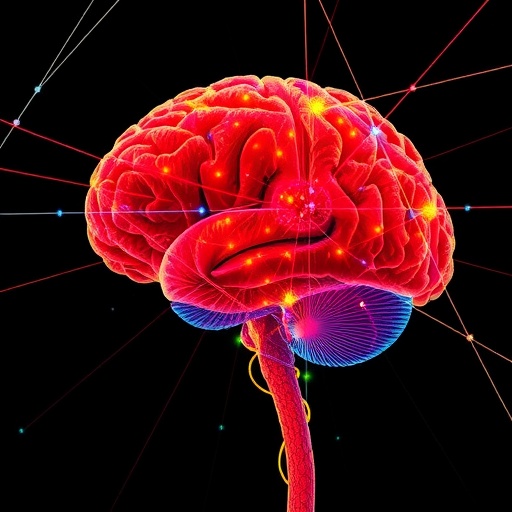In a groundbreaking stride towards combating one of psychiatry’s most challenging dilemmas, a recent study has unveiled the potential of functional near-infrared spectroscopy (fNIRS) combined with advanced machine learning techniques to objectively classify suicidal ideation among patients with major depressive disorder (MDD). Published in BMC Psychiatry in 2025, this innovative research addresses the critical need for reliable biomarkers in the early diagnosis of suicidal risk, which historically has hinged on subjective clinical assessments fraught with ambiguity and inconsistency.
Major depressive disorder remains a leading cause of disability worldwide, with suicidal ideation posing a particularly grave threat. Traditional diagnostic approaches rely heavily on patient self-reports and clinician evaluations, tools that, while valuable, lack the precision required for timely intervention. The emergence of neuroimaging modalities such as fNIRS offers a promising avenue for detecting subtle yet clinically significant brain function abnormalities linked to suicidal thoughts. This non-invasive technology measures cerebral hemodynamic responses by tracking oxygenated hemoglobin levels, revealing the intricate neural activity especially within the prefrontal cortex, a region implicated in emotional regulation and decision-making.
What elevates this study above prior efforts is its integration of deep learning methodologies—specifically, one-dimensional convolutional neural networks (CNNs)—for analyzing fNIRS data. While traditional machine learning approaches have provided preliminary insights, they often fall short in capturing the complex temporal dynamics inherent in brain signals. The use of CNNs not only enhances classification accuracy but also paves the way for more robust, automated diagnostic pipelines that could transform clinical practice.
The research team recruited 91 first-episode, drug-naive individuals diagnosed with MDD, subdividing them based on scores from the suicidal item of the Hamilton Depression Rating Scale (HAMD-17) into those with suicidal ideation (SIs) and those without (NSIs). A control cohort of 39 healthy subjects provided baseline measures. Participants underwent fNIRS scanning while performing a verbal fluency task (VFT), a cognitive challenge known to activate the prefrontal cortex. The team meticulously analyzed oxyhemoglobin concentration changes across several prefrontal subregions, seeking patterns that distinguish between the groups.
Statistical analyses revealed compelling differences: NSIs exhibited significant hypoactivation in the left dorsolateral prefrontal cortex (lDLPFC), frontopolar cortex (FPC), orbitofrontal cortex (OFC), and ventrolateral prefrontal cortex (VLPFC) compared to healthy controls. More strikingly, SIs demonstrated widespread diminished activation throughout the entire prefrontal cortex, underscoring the neural severity associated with suicidal ideation. Notably, the SIs’ activity in DLPFC, FPC, and OFC was significantly lower than that observed in NSIs, suggesting these regions as critical biomarkers for suicidal thoughts in MDD.
Leveraging the high-dimensional data yielded by fNIRS, the deep learning model achieved a three-class classification accuracy of 69.8%, with the left frontopolar cortex (lFPC) serving as the most discriminative region. The receiver operating characteristic (ROC) curve analyses further substantiated these findings: the right frontopolar cortex (rFPC) exhibited an area under the curve (AUC) of 0.88 for the SI group, signifying strong diagnostic power, whereas the NSI group demonstrated an equal AUC in the right dorsolateral prefrontal cortex (rDLPFC). Healthy controls showed the highest discriminability in the rDLPFC and right ventrolateral prefrontal cortex (rVLPFC), with an impressive AUC of 0.92.
This nuanced mapping of prefrontal dysfunction not only aligns with existing neurobiological theories implicating these cortical regions in mood and suicidality but also underscores the potential utility of fNIRS during the VFT as a practical, clinical tool. Unlike other neuroimaging techniques such as functional magnetic resonance imaging (fMRI), fNIRS offers a more accessible, portable, and patient-friendly platform, particularly advantageous for psychiatric populations where motion artifacts and discomfort often pose significant challenges.
Beyond the technical achievements, the study carries profound clinical implications. Identifying reliable neural markers can shift the paradigm from reactive to proactive mental health care, facilitating early identification of patients at heightened suicide risk without solely depending on patient self-reporting. The ability to deploy such objective tools in diverse clinical settings promises to enhance personalized treatment planning and potentially reduce suicide rates.
While the findings are promising, the authors acknowledge certain limitations that warrant future research. The sample size, though robust for initial modeling, requires expansion and replication across diverse demographics to ensure generalizability. Further exploration into longitudinal changes in prefrontal activation post-treatment could also illuminate how neural biomarkers fluctuate with symptom remission or relapse, enriching their prognostic value.
Moreover, integrating multimodal data—combining fNIRS with electroencephalography (EEG), genetic profiles, or behavioral metrics—could augment the robustness of predictive models. As machine learning algorithms continue to evolve, the fusion of these data streams may unlock deeper insights into the pathophysiology of suicidality and mood disorders.
In an era increasingly defined by precision medicine, this pioneering study represents a compelling step forward. By harnessing state-of-the-art neuroimaging and computational techniques, researchers are edging closer to an era where objective, brain-based diagnostics complement clinical intuition, ultimately paving the way for more effective suicide prevention strategies in major depressive disorder.
The implications of these findings extend beyond immediate psychiatric care. Research like this holds promise for reshaping how mental health is understood and treated in broader society—offering hope that science-driven innovations can address the silent burdens of mental illness with unprecedented sensitivity and accuracy.
As neuroscience and artificial intelligence continue their rapid convergence, studies employing fNIRS and deep learning stand at a critical crossroad. They illuminate complex neural signatures previously hidden in noisy signals and open promising new frontiers for mental health diagnostics that are accessible, scalable, and deeply personalized, redefining the boundaries of what is possible in clinical psychiatry.
Subject of Research: Neural biomarkers for suicidal ideation in first-episode drug-naive major depressive disorder patients using functional near-infrared spectroscopy and machine learning.
Article Title: Classify the fNIRS signals of first-episode drug-naive MDD patients with or without suicidal ideation using machine learning.
Article References:
Mou, L., Shen, Y., Tan, Q. et al. Classify the fNIRS signals of first-episode drug-naive MDD patients with or without suicidal ideation using machine learning. BMC Psychiatry 25, 909 (2025). https://doi.org/10.1186/s12888-025-07394-y
Image Credits: AI Generated
DOI: https://doi.org/10.1186/s12888-025-07394-y




